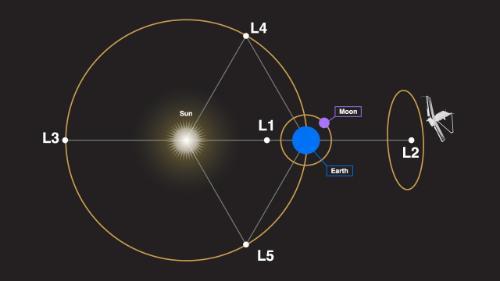VMI Chemistry Professor Looks at Cosmic Ice

The image illustrates the Lagrange point keeping the Earth between the telescope and the sun.—Image courtesy of NASA
LEXINGTON, Va. April 8, 2025 — Maj. Christopher N. Shingledecker, assistant professor of chemistry at Virginia Military Institute, recently learned that a research proposal he submitted to the Space Telescope Science Institute (STScI) has been accepted.
The proposal titled, “A New Modeling Toolkit for JWST Ice Observations,” describes the construction of theoretical models to support observations with the James Webb Space Telescope (JWST), the largest telescope in space. Proposal applications to the STScI are highly competitive, and his was judged to be in the top 11% of more than 200 submitted in the theory category.
The JWST, which is an infrared observatory, allows astronomers to observe objects blocked by dust and gas in the visible light spectrum. It was launched on Christmas Day 2021, and is orbiting approximately 1 million miles from Earth, where it circles L2, a so-called Lagrange point selected to keep the Earth between the telescope and the sun.
Shingledecker illustrated, “These are points around Earth that are particularly gravitationally stable. The Hubble Space Telescope is fairly close to Earth, orbiting at an average altitude of about 300 miles. It’s a space telescope, but metaphorically, it’s still in the Earth’s backyard. The JWST is four times further from the Earth than the moon. It’s very much a space telescope. So now you’re not just camping in the backyard, now you’re camping in Shenandoah National Park.”
Shingledecker, who is the principal investigator (PI) of the project, is working with two other researchers, Andrew Burkhart, Ph.D., assistant professor of physics at Worcester State University in Massachusetts, and Serena Viti, Ph.D., professor of astronomy at Universiteit Leiden in the Netherlands.
Their goal is to take an astrochemical model Viti developed with her students, called UCLCHEM, and incorporate into it some of the various astrochemical theories Shingledecker has developed.
“What we’re going to be looking at in particular is cosmic ice. JWST is one of the few observatories that allows us to see cosmic ice, but there’s a problem. Even though you can observe these ices better than ever before, getting information about their composition has been challenging because we don’t have good models to predict what those ices should be made of, so that’s what we will be working on. We want to make it easier to go from observations to conclusions for people who want to study cosmic ice,” explained Shingledecker.
Shingledecker, who also serves as vice chair of the American Chemical Society astrochemsitry subdivision, stated that the project should take two years to complete and will involve the work of several VMI cadets. The funding received will support the study of astrochemistry at VMI.
Marianne Hause
Communications & Marketing
VIRGINIA MILITARY INSTITUTE
.svg)
.png)